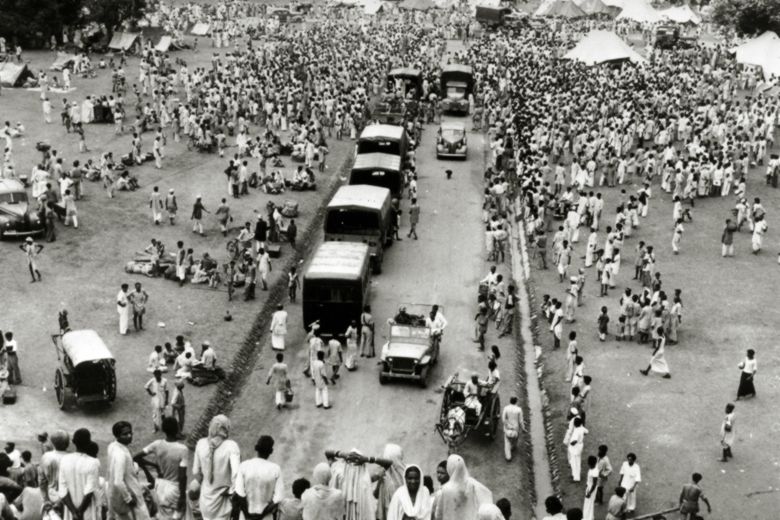In 2013 Google released an advertisement featuring an elderly Hindu man in Delhi, Baldev, who is reminiscing about a Muslim playmate, Yusuf, from his childhood in Lahore. Baldev hasn’t seen Yusuf in many decades, having migrated from Pakistan to India during Partition, and he misses him. Baldev’s attentive granddaughter, Suman, uses Google to search for Yusuf and manages to track down his Pakistani grandson, Ali. The pair arrange for Yusuf to travel from Lahore to Delhi. With the help of Google, Ali easily figures out how to attain a visa for Yusuf, who is soon standing at Baldev’s doorstep. The long-lost friends embrace; the Google logo flashes. Soon the old men are getting blissfully drenched together beneath a rainy sky. Thanks to technological progress, they have been able to overcome decades of trauma, geopolitical strife and communal discord.
Various commentators in India, the United States, Canada and Malaysia have showered praise on this advert, and it has been viewed more than 13 million times. But despite its laudable message of cross-border religious harmony, it is perhaps more notable for its lacunae, which reveal a great deal about the way in which Partition is remembered today. For example, the advert centres on two men, though Partition disproportionately affected the lives of women. Furthermore, it doesn’t contain the slightest trace of the British Empire, even though it was Britain, in conjunction with the Indian leaders it favoured at various points during colonial rule, who imposed Partition on the country without adequately preparing it. Hindus, Muslims and Sikhs sometimes experienced tension before colonialism, but Britain deliberately engineered policies that fomented strife between these groups in order to manage its imperial holdings more effectively. It pitted the Muslim League of Muhammad Ali Jinnah and the Congress Party of Mohandas Gandhi against one another, putting India on a crash course towards division and destruction.
The elisions in the advert aren’t surprising. The diminishment of imperial responsibility for the woes of Partition has a long history. In an article about Indian independence in 1947, Time magazine praised the justness of a British legal system in the Raj that denied basic human rights to ordinary Indians. It claimed that “by the time the British reached India, both Hindu and Moslem were deeply immersed in hate”. The Atlantic, in 1958, asserted that “long before the British conquered India, the Hindus had resented their Muslim Mogul masters”. Around the same time, Anglo-American readers were delighting in Khushwant Singh’s finely constructed Partition novel Train to Pakistan (1956) – a book that contains not a single British character. The fact that Singh’s family made a fortune collaborating with the Raj perhaps explains this omission.
In recent decades, scholars such as Gyanendra Pandey and Yasmin Khan have helped to unravel the complex role the British played in encouraging the religious discord that still beleaguers South Asia today, and yet the tendency to downplay the role of the colonizer in Partition persists in many English-language texts. Even seemingly nuanced accounts can’t seem to shake off this habit. Take Nisid Hajari’s book Midnight’s Furies (2015), which received thunderous acclaim in the US, UK and India. It presents provocative evidence of British imperialists actively fanning the flames of communal discord by paying off Muslim clerics to preach against the Congress Party, and yet the author seems reluctant to rigorously scrutinize British actions and attitudes leading up to Partition. He often makes light of the role of imperial actors, such as Viceroy Mountbatten; he rehashes old tropes about the “deep roots” of divisions between Hindus and Muslims, mentioning age-old “frictions” stemming from the destruction of “flower-strewn temples” by “Muslim conquerors”. Various scholars, including Audrey Truschke and Romila Thapar, have demonstrated the tenuousness of such claims. Thapar, for example, has pointed out that alleged Hindu grievances about the eleventh-century destruction of the Somnath temple were first aired in Britain’s Parliament; only after this point do records begin to reference “the Hindu trauma”.
It is true, as many critics have pointed out, that South Asian thinkers and politicians would do well to reckon with the culpability of their own leaders and citizens in carrying out Partition and perpetuating religious violence. As the legacy of twentieth-century imperialism continues to inform our current moment of global instability, it is similarly imperative for Anglo-American audiences to see through the simplicities epitomized by Google’s Partition commercial.
(…)


